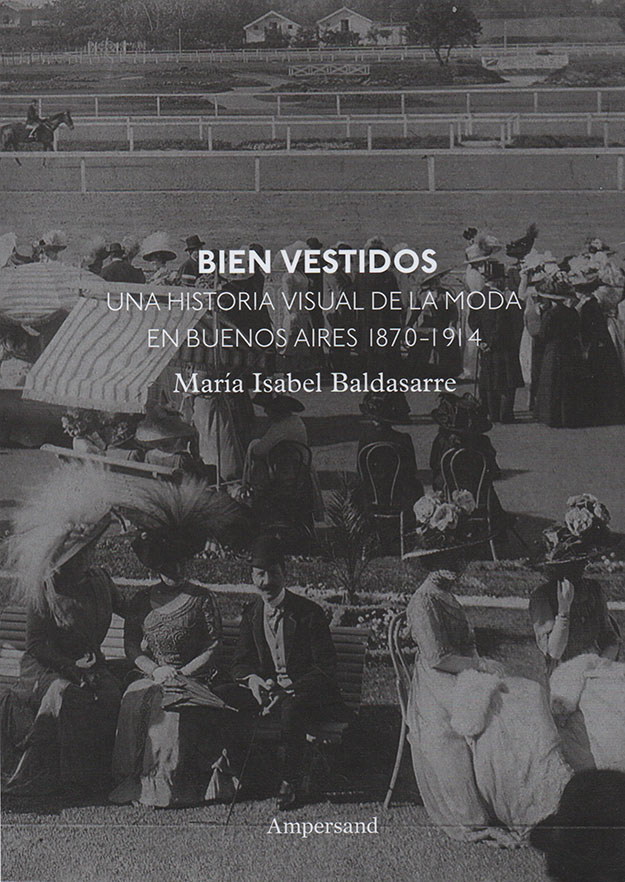Bien vestidos. Una historia visual de la moda en Buenos Aires 1870 - 1914. María Isabel Baldasarre. Colección Estudios de Moda, Ampersand, Buenos Aires, 2021.
Quarto (24 x 17 cm), 383 pp. Paperback publisher binding.
Dr. María Isabel Baldasarre studies in depth the subject of clothing in a broad sense; She does so by addressing her links with visual culture, consumption and cultural practices carried out by various social sectors of Buenos Aires in the period of the so-called belle epoque, that is, between 1870 and 1914.
This city underwent an unparalleled transformation in those years. On the one hand and at the national level, between 1890 and 1920 Argentina's per capita gross domestic product was the highest in the region, comparable to developed countries such as France or Germany. In turn, of the little more than two hundred thousand inhabitants that the city had, by 1920 that figure multiplied by nine, registering 1,779,500 inhabitants. This economic and population development germinated a large consumer market, in which clothing, in its high-end imported from Europe, found an ideal environment for its expansion and consumption. The city began its period of modernization and became a regional fashion reference center, and later on a site of pilgrimage and emulation, largely due to its successful assimilation of European culture.
“The purpose of this book is to contribute -from social history, art history, fashion theory and visual and gender studies- to mapping the dress cultures in Buenos Aires, to knowing the habits, but also, the dreams clothing of its inhabitants and the representations that were made of them between the last quarter of the 19th century and the first of the 20th. To carry out these objectives my repertoire will be wide: journalistic publications, notices, humorous cartoons, catalog of stores, clothing items, sewing and home economics manuals, figurines, photographs, memories, business guides, official documents, among others”, we read in the introduction of Baldasarre. Indeed, the book is profusely illustrated with photographs of private collections of personalities so dear to our house, such as Luis Priamo and Dr. César Gotta.
It is inescapably on women that the focus of study of this book rests. The interest in fashion and the passion for its consumption was a trait intrinsically associated with the female gender. Let us also consider that every woman of that time handled the arts of sewing, accompanied by the new sewing machine. But the analysis expands towards social and political features. Baldasarre maintains that “the main hypothesis that runs through this book understands fashion, or rather the adherence of porteñas to the parameters of European fashion, as part of a dual process of normalization and modernization. Dressing in fashion allowed individuals to civilize, regulate their behaviors, mark and display the sexual differentiation of bodies”.
Lovers of the history of Buenos Aires, photography and iconography from the 19th and early 20th centuries will find on these pages extremely useful information, for example, when identifying dates through the clothing of a carte-de-visite, and to contextualize the social rites of that time, inhabited in its streets, parks, cafes, theaters, shops, schools, hospitals, clubs. Knowing the clothing habits of its inhabitants and passers-by, the places where clothing was manufactured, offered for sale and even worn, also leads us to better understand why Buenos Aires was conceived, observed and lived as a city in full modernization.
María Isabel Baldasarre has a doctorate in Art History and a degree in Arts from the University of Buenos Aires and a researcher at CONICET. She is the author of Los dueños del arte. Coleccionismo y consumo cultural en Buenos Aires; She is the editorial coordinator of the volumes Museo Nacional de Bellas Artes: Colección and co-editor of Travesías de la imagen. Historia de las artes visuales en Argentina. At present, she is a tenured professor at the Interdisciplinary School of High Social Studies (IDAES, UNSAM) and national director of museums of the Secretariat of Cultural Heritage of the Ministry of Culture of the Nation.
